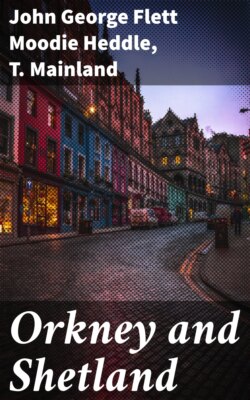Читать книгу Orkney and Shetland - John George Flett Moodie Heddle - Страница 5
На сайте Литреса книга снята с продажи.
2. General Characteristics and Natural Conditions
ОглавлениеTable of Contents
Rackwick, Hoy
Orkney occupies the somewhat anomalous position of being a wholly insular shire whose economic interests are overwhelmingly agricultural. Most of the islands are flat or low; and in several, such as Shapinsay, Stronsay, Sanday, and South Ronaldshay, the proportion of cultivated land exceeds 70 per cent. of their total areas. In the Mainland, however, there are large stretches of hill and moorland, while in Hoy and Walls the natural conditions of by far the greater portion of the island closely approximate to those of the Scottish Highlands. Rousay is the only other island which is to a large extent hilly; but Westray and Eday have some hills, and Burray, Flotta, and several other islands considerable stretches of low-lying moor. The general rise of the land is from N.E. to S.W. A height of 334 feet is attained at the Ward Hill at the south end of Eday, 880 feet at the Ward Hill of Orphir, in the S.W. of the Mainland, 1420 at Cuilags, 1564 at Ward Hill, and 1309 at Knap of Trowieglen, the three highest points in Hoy and in the whole group. Exceptionally fine views are obtained from Wideford Hill (741 feet), near Kirkwall, and from the Ward Hill in Hoy, the varied panoramas of islands, sounds, and lakes perhaps gaining in grace of outline more than they lose in richness of detail from the woodless character of the country.
Taken in detail, and viewed from the low ground, however, the general aspect of much of the country is bleak, and only redeemed from baldness by the widely-spread evidence of a vigorous cultivation. Yet for reasons of a somewhat complex texture, involving meteorological conditions, historical and archaeological considerations, and a touch of all-round individuality, the Islands rarely fail to cast a spell upon the visitor. One might quote many distinguished writers to vouch for this fact, but an Orcadian poet has depicted the telling features of his native land, both physical and psychic, with unerring accuracy and skill.
Land of the whirlpool, torrent, foam,
Where oceans meet in maddening shock;
The beetling cliff, the shelving holm,
The dark, insidious rock;
Land of the bleak, the treeless moor,
The sterile mountain, seared and riven;
The shapeless cairn, the ruined tower,
Scathed by the bolts of heaven;
The yawning gulf, the treacherous sand;
I love thee still, my native land!
Land of the dark, the Runic rhyme,
The mystic ring, the cavern hoar,
The Scandinavian seer, sublime
In legendary lore;
Land of a thousand sea-kings’ graves—
Those tameless spirits of the past,
Fierce as their subject Arctic waves,
Or hyperborean blast;
Though polar billows round thee foam,
I love thee!—thou wert once my home.
With glowing heart and island lyre,
Ah! would some native bard arise
To sing, with all a poet’s fire,
Thy stern sublimities—
The roaring flood, the rushing stream,
The promontory wild and bare,
The pyramid where sea-birds scream
Aloft in middle air,
The Druid temple on the heath,
Old even beyond tradition’s breath.
If we allow a little for the softer side of the picture, a side perhaps best typified by the fine old buildings of the little island capital, and the spell of the lightful midsummer night, which is no night, the lines of Vedder form a fair compendium of the natural conditions and general characteristics of the Islands to-day, although much of the “bleak and treeless moor” of the poet’s youth has long since been converted into smiling fields of corn.
